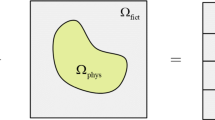Abstract
This paper presents a mathematical programming based approach for the analysis of elastoplastic softening frames in the presence of geometric nonlinearity. Arbitrarily large deformations, albeit within a small strain regime, can be accommodated, if necessary. For the sake of efficiency, and without undue loss of accuracy, the algorithm processes the nonholonomic (path-dependent) problem in a stepwise holonomic (path-independent) fashion. This analysis capability has been used to investigate what level or order of geometric nonlinearity needs to be adopted to obtain sufficiently accurate results for practical frames. Two examples are provided for illustrative purposes.
Similar content being viewed by others
References
Ardito R, Cocchetti G, Maier G (2008) On structural safety assessment by load factor maximization in piecewise linear plasticity. Eur J Mech A Solids 27: 859–881
Armero F, Ehrlich D (2006) Numerical modeling of softening hinges in thin Euler-Bernoulli beams. Comput Struct 84: 641–656
Bird WW, Martin JB (1990) Consistent predictors and the solution of the piecewise holonomic incremental problem in elastoplasticity. Eng Struct 12: 9–14
Bolzon G, Corigliano A (1997) A discrete formulation for elastic solids with damaging interfaces. Comput Methods Appl Mech Eng 140: 329–359
Bolzon G, Maier G, Tin-Loi F (1997) On multiplicity of solutions in quasi-brittle fracture computations. Comput Mech 19: 511–516
Bolzon G, Tin-Loi F (1999) Physical instability and geometric effects in frames. Eng Struct 21: 557–567
Brooke A, Kendrick D, Meeraus A, Raman R (1998) GAMS: a user’s guide. GAMS Development Corporation, Washington DC
Chen WF, Lui EM (1991) Stability design of steel frames. CRC Press, Boca Raton
Cocchetti G, Maier G (2003) Elastic-plastic and limit-state analyses of frames with softening plastic-hinge models by mathematical programming. Int J Solids Struct 40: 7219–7244
Cocchetti G, Maier G, Shen XP (2002) Piecewise linear models for interfaces and mixed mode cohesive cracks. Comput Model Eng Sci 3: 279–298
Comi C, Maier G (1990) Extremum theorem and convergence criterion for an iterative solution to the finite-step problem in elastoplasticity with mixed nonlinear hardening. Eur J Mech A Solids 9: 563–585
Cottle RW, Pang JS, Stone RE (1992) The linear complementarity problem. Academic Press, San Diego
De Freitas JAT, Lloyd Smith D (1984–1985) Elastoplastic analysis of planar structures for large displacements. ASCE J Struct Mech 12: 419–445
Dirkse SP, Ferris MC (1995) The PATH solver: a nonmonotone stabilization scheme for mixed complementarity problems. Optim Methods Softw 5: 123–156
Ehrlich D, Armero F (2005) Finite element methods for the analysis of softening plastic hinges in beams and frames. Comput Mech 35: 237–264
Ferris MC (1998) MATLAB-GAMS: interfacing optimization and visualization software. Technical report TR98-19, Computer Sciences Department, University of Wisconsin, Madison
Forde BWR, Stiemer SF (1987) Improved arc length orthogonality methods for nonlinear finite element analysis. Comput Struct 27: 625–630
Franchi A, Grierson DE, Cohn MZ (1981) A computer system for the elastic-plastic analysis of large-scale structures. Mech Struct Mach 9: 295–324
Kassimali A (1983) Large deformation analysis of elastic-plastic frames. ASCE J Struct Eng 109: 1869–1886
Maier G (1970) A matrix structural theory of piecewise linear elastoplasticity with interacting yield planes. Meccanica 5: 54–66
Maier G (1971) Incremental plastic analysis in the presence of large displacements and physical instabilizing effects. Int J Solids Struct 7: 345–372
Maier G (1976) Piecewise linearization of yield criteria in structural plasticity. Solid Mech Arch 2: 239–281
Maier G, Novati G (1990) Extremum theorems for finite-step backward-difference analysis of elastic-plastic nonlinearly hardening solids. Int J Plast 6: 1–10
Maier G, Zavelani A, Dotreppe JC (1973) Equilibrium branching due to flexural softening. ASCE J Struct Div 99: 897–906
Massonnet CE, Save MA (1965) Plastic analysis and design: beams and frames, vol 1. Blaisdell Publishing Co., New York
Mistakidis ES (2000) A heuristic method for nonconvex optimization in mechanics: conceptual idea, theoretical justification, engineering applications. J Glob Optim 17: 301–316
Müller M (2007) Passing of instability points by applying a stabilized Newton-Raphson scheme to a finite element formulation: comparison to arc-length method. Comput Mech 40: 683–705
Papadrakakis M, Papadopoulos V (1995) A computationally efficient method for the limit elasto plastic analysis of space frames. Comput Mech 16: 132–141
Przemieniecki JS (1985) Theory of matrix structural analysis. Dover Publication Inc., New York
Saafan SA (1963) Nonlinear behaviour of structural plane frames. ASCE J Struct Div 89: 557–579
Tangaramvong S, Tin-Loi F (2007) A complementarity approach for elastoplastic analysis of strain softening frames under combined bending and axial force. Eng Struct 29: 742–753
Tangaramvong S, Tin-Loi F (2009) Limit analysis of elastoplastic frames considering 2nd-order geometric nonlinearity and displacement constraints. Int J Mech Sci 51: 179–191
Tangaramvong S, Tin-Loi F (2009) Extended limit analysis of strain softening frames involving 2nd-order geometric nonlinearity and limited ductility. Comput Model Eng Sci 42: 217–256
Tin-Loi F, Misa JS (1996) Large displacement elastoplastic analysis of semirigid steel frames. Int J Numer Methods Eng 39: 741–762
Tin-Loi F, Tangaramvong S, Xia SH (2007) Limit analysis of frames involving unilateral supports with frictional contact. Int J Mech Sci 49: 454–465
Author information
Authors and Affiliations
Corresponding author
Rights and permissions
About this article
Cite this article
Tangaramvong, S., Tin-Loi, F. The influence of geometric effects on the behavior of strain softening frames. Comput Mech 46, 661–678 (2010). https://doi.org/10.1007/s00466-010-0508-y
Received:
Accepted:
Published:
Issue Date:
DOI: https://doi.org/10.1007/s00466-010-0508-y




